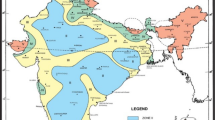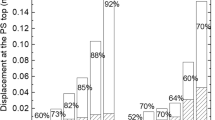Abstract
Due to the complex canyon topography in southwestern regions of China, several multi-main-span high pier continuous rigid-frame bridges (MHPCRFBs) are built to meet the special terrain. Owing to the great effect of high-order modes, the seismic responses of MHPCRFBs are more complicated than the conventional signal main span continuous rigid-frame bridges. However, there has been very limited researches focus on the seismic vulnerability of MHPCRFBs. This study selects a practical five-span (three main span) high pier continuous rigid-frame bridge as a study object to investigate the seismic vulnerability of MHPCRFBs under near-field pulse-like seismic wave excitation. And a finite element model of the example bridge is built by OpenSees incorporating the influence of abutment, and simultaneously 100 near-field pulse-like seismic waves are chosen to research their effect on the seismic vulnerability of the MHPCRFB. The dynamic nonlinear time-history analyses are carried out to record the peak demand values of the example bridge under three seismic excitation calculation cases (longitudinal earthquake, biaxial earthquake, and triaxial earthquake). Thirty-three intensity measures are compared with respect to two statistical parameters including correlation efficient and root mean square error, the peak ground velocity (PGV) turns out to be the optimal intensity measure for seismic vulnerability analysis of MHPCRFB. Subsequently, by using the analysis procedures of the cloud method, the seismic vulnerability curves of MHPCRFB are developed and compared. The results of this study show that the bottom and top areas of the high piers are more fragile at the slight and moderate damage stages along longitudinal direction, and only the bottom areas are prone to damage along transverse direction. And the seismic wave excitation directions have an obvious influence on the seismic damage probability of the MHPCRFB. In addition, the zone with larger failure probabilities of the lower pier is significantly longer than the higher pier. The obtained results provide helpful reference for the seismic-resistant design and consolidation of MHPCRFBs, shed light on the lower pier of MHPCRFBs should be paid high concern to the anti-seismic design.
Similar content being viewed by others
References
Aviram A, Mackie KR, Stojadinović B (2008) Guidelines for nonlinear analysis of bridge structures in California. PEER Report No. 2008-03, Pacific Earthquake Engineering Research Center, University of California, Berkeley, CA, USA
Baker JW (2007) Quantitative classification of near-fault ground motions using wavelet analysis. Bulletin of the Seismological Society of America 97(5):1486–1501, DOI: https://doi.org/10.1785/0120060255
Baker JW, Cornell CA (2006) Vector-valued ground motion intensity measure for probabilistic seismic demand analysis. PEER Report No. 2006-08, Pacific Earthquake Engineering Research Center, University of California, Berkeley, CA, USA
Billah AHMM, Alam MS (2015) Seismic fragility assessment of highway bridges: A state-of-the-art review. Structure and Infrastructure Engineering 11(6):804–832, DOI: https://doi.org/10.1080/15732479.2014.912243
Billah AHMM, Alam MS (2021) Seismic fragility assessment of multi-span concrete highway bridges in British Columbia considering soil-structure interaction. Canadian Journal of Civil Engineering 48(1):39–51, DOI: https://doi.org/10.1139/cjce-2018-0667
Billah AHMM, Alam MS, Bhuiyan MAR (2013) Fragility analysis of retrofitted multicolumn bridge bent subjected to near-fault and far-field ground motion. Journal of Bridge Engineering 18(10):992–1004, DOI: https://doi.org/10.1061/(ASCE)BE.1943-5592.0000452
Caltrans (2010) Caltrans seismic design criteria Version 1.6. Sacramento, CA: California Department of Transportation
Cao Y, Liang Y, Huai CZ, Yang J, Mao RM (2020) Seismic fragility analysis of multispan continuous girder bridges with varying pier heights considering their bond-slip behavior. Advances in Civil Engineering 2020:8869921, DOI: https://doi.org/10.1155/2020/8869921
Ceravolo R, Demarie GV, Giordano L, Mancini G, Sabia D (2009) Problems in applying code-specified capacity design procedures to seismic design of tall piers. Engineering Structures 31(8):1811–1821, DOI: https://doi.org/10.1016/j.engstruct.2009.02.042
Chen X (2020) System fragility assessment of tall-pier bridges subjected to near-fault ground motions. Journal of Bridge Engineering 25(3): 04019143, DOI: https://doi.org/10.1061/(ASCE)BE.1943-5592.0001526
Chen F, Gu XY, Shan DS, Dong J, Li Q (2018a) Seismic fragility analysis of irregular continuous rigid frame girder bridge. Cogent Engineering 5(1):1545741, DOI: https://doi.org/10.1080/23311916.2018.1545741
Chen X, Guan ZG, Li JZ, Spencer BF (2018b) Shake table tests of tall-pier bridges to evaluate seismic performance. Journal of Bridge Engineering 23(9):04018058, DOI: https://doi.org/10.1061/(ASCE)BE.1943-5592.0001264
Chen X, Li JZ, Guan ZG (2020) Fragility analysis of tall pier bridges subjected to near-fault pulse-like ground motions. Structure and Infrastructure Engineering 16(8):1082–1095
Cornell CA, Jalayer F, Hamburger RO, Foutch DA (2002) Probabilistic basis for 2000 SAC federal emergency management agency steel moment frame guidelines. Journal of Structural Engineering 128(4): 526–533, DOI: https://doi.org/10.1061/(ASCE)0733-9445(2002)128:4(526)
Ebrahimi Motlagh HR, Tehrani P (2021) Seismic fragility analysis of concrete bridges subjected to far- and near-field records. Proceedings of the Institution of Civil Engineers–Structures and Buildings: In press, DOI: https://doi.org/10.1680/jstbu.20.00284
Ellingwood B, Galambos TV, MacGregor JG, Cornell CA (1980) Development of a probability based load criterion for American national standard A58 - building code requirements for minimum design loads in buildings and other structures. Department of Commerce, National Bureau of Standards, Washington DC, USA
GB 50011-2010 (2010) Code for seismic design of buildings. Ministry of Housing and Urban-Rural Development of the People’s Republic of China, Beijing, China (in Chinese)
GB50010-2010 (2010) Code for design of concrete structures. Ministry of Housing and Urban-Rural Development of the People’s Republic of China, Beijing, China (in Chinese)
Hall JF, Heaton TH, Halling MW, Wald DJ (1995) Near-source ground motion and its effects on flexible buildings. Earthquake Spectra 11(4):569–605, DOI: https://doi.org/10.1193/1.1585828
Hason MM, Al-Zuhairi AH, Hanoon AN, Abdulhameed AA, Zand AWA, Abbood IS (2022) Peak ground acceleration models predictions utilizing two metaheuristic optimization techniques. Latin American Journal of Solids and Structures 19(3):e447, DOI: https://doi.org/10.1590/1679-78256940
Hason MM, Hanoon AN, Abdulhameed AA (2021) Particle swarm optimization technique based prediction of peak ground acceleration of Iraq’s tectonic regions. Journal of King Saud University - Engineering Sciences 2021, DOI: https://doi.org/10.1016/j.jksues.2021.06.004
Hu N, Dai GL, Yan B, Liu K (2014) Recent development of design and construction of medium and long span high-speed railway bridges in China. Engineering Structures 74:233–241, DOI: https://doi.org/10.1016/j.engstruct.2014.05.052
Hwang H, Liu JB, Chiu YH (2001) Seismic fragility analysis of highway bridges. Mid-America Earthquake Center Technical Report No. MAEC RR-4. University of Memphis, Memphis, Tennessee, USA
JCSS (2001) Probabilistic modal code. Joint Committee on Structural Safety (JCSS), Retrieved September 16, 2019, https://www.jcss-lc.org/jcss-probabilistic-model-code
Jia HY, Zhang DY, Zheng SX, Xie WC, Pandey MD (2013) Local site effects on a high-pier railway bridge under tridirectional spatial excitations: Nonstationary stochastic analysis. Soil Dynamics and Earthquake Engineering 52:55–69, DOI: https://doi.org/10.1016/j.soildyn.2013.05.001
JT391-1999 (1999) Pot-type elastomeric pad bearing for highway bridge. Ministry of Transport of the People’s Republic of China. Beijing, China (in Chinese)
Kia M, Amini A, Bayat M, Ziehl P (2021) Probabilistic seismic demand analysis of structures using reliability approaches. Journal of Earthquake and Tsunami 15(3):2150011, DOI: https://doi.org/10.1142/S1793431121500111
Li XQ, Li ZX, Crewe AJ (2018) Nonlinear seismic analysis of a high-pier, long-span, continuous RC frame bridge under spatially variable ground motions. Soil Dynamics and Earthquake Engineering 114: 298–312, DOI: https://doi.org/10.1016/j.soildyn.2018.07.032
Lu DG, Yu XH, Pan F, Wang GY (2008) Probabilistic seismic demand analysis considering random system properties by an improved cloud method. The 14th World Conference on Earthquake Engineering (WCEE14), October 12–17, Beijing, China
Ma WY, Zhou YJ (2009) Seismic load dynamic analysis and reliability design principle for engineering structures. China Water & Power Press, Beijing, China (in Chinese)
Malhotra PK (1999) Response of buildings to near-field pulse-like ground motions. Earthquake Engineering and Structural Dynamics 28(11): 1309–1326, DOI: https://doi.org/10.1002/(SICI)1096-9845(199911)28:11<1309::AID-EQE868>3.0.CO;2-U
Maroney BH, Chai YH (1994) Bridge abutment stiffness and strength under earthquake loadings. Proceedings of the 2nd International Workshop on the Seismic Design of Bridges, August 9–12, Queenstown. New Zealand
McKenna F, Scott MH, Fenves GL (2010) Nonlinear finite-element analysis software architecture using object composition. Journal of Computing in Civil Engineering 24(1):95–107, DOI: https://doi.org/10.1061/(ASCE)CP.1943-5487.0000002
Nielson BG (2005) Analytical fragility curves for highway bridges in moderate seismic zones. PhD Thesis, Georgia Institute of Technology, Atlanta, GA, USA
Padgett JE, DesRoches R (2008) Methodology for the development of analytical fragility curves for retrofitted bridges. Earthquake Engineering and Structural Dynamics 37(8):1157–1174, DOI: https://doi.org/10.1002/eqe.801
Padgett JE, Nielson BG, DesRoches R (2008) Selection of optimal intensity measures in probabilistic seismic demand models of highway bridge portfolios. Earthquake Engineering and Structural Dynamics 37(5):711–725, DOI: https://doi.org/10.1002/eqe.782
Priestley MN, Seible F, Calvi GM (1996) Seismic design and retrofit of bridges. John Wiley & Sons, Inc., New York, NY, USA, DOI: https://doi.org/10.1002/9780470172858
Ren LP, Zhang G, Zhang YF, He SH (2020) Seismic fragility analysis of V-shaped continuous girder bridges. KSCE Journal of Civil Engineering 24(3):835–846, DOI: https://doi.org/10.1007/s12205-020-0805-8
Shafieezadeh A, Ramanathan K, Padgett JE, DesRoches R (2012) Fractional order measures for probabilistic seismic demand modeling applied to highway bridges. Earthquake Engineering and Structural Dynamics 41(3):391–409, DOI: https://doi.org/10.1002/eqe.1135
Shahi SK, Baker JW (2014) An efficient algorithm to identify strong-velocity pulses in multicomponent ground motions. Bulletin of the Seismological Society of America 104(5):2456–2466, DOI: https://doi.org/10.1785/0120130191
Shao YH, Wei YY, Yang T, Ni M, Zhong J (2021) Empirical models of bridge seismic fragility surface considering the vertical effect of near-fault ground motions. Structures 34:2962–2973, DOI: https://doi.org/10.1016/j.istruc.2021.09.021
Tubaldi E, Tassotti L, Dall’Asta A, Dezi L (2014) Seismic response analysis of slender bridge piers. Earthquake Engineering and Structural Dynamics 43(10):1503–1519, DOI: https://doi.org/10.1002/eqe.2408
Vamvatsikos D, Cornell CA (2002) Incremental dynamic analysis. Earthquake Engineering and Structural Dynamics 31(3):491–514, DOI: https://doi.org/10.1002/eqe.141
Whitman RV, Biggs JM, Brennan JE, Cornell CA, De Neufville RL, Vanmarcke EH (1975) Seismic design decision analysis. Journal of the Structural Division 101(5):1067–1084
Wu FW, Zhou JW, Zhao YY, Wang GQ, Tang WL, Luo JF, Ibrahim U, Meng YY (2021) Performance-based seismic fragility and risk assessment of five-span continuous rigid frame bridges. Advances in Civil Engineering 2021:6657663, DOI: https://doi.org/10.1155/2021/6657663
Wu WP (2015) Seismic fragility of reinforced concrete bridges with consideration of various sources of uncertainty. PhD Thesis, Hunan University, Changsha, HN, China (in Chinese)
Yie LP, Ma QL, Miao ZW (2009) Study on earthquake intensities for seismic analysis of structures. Journal of Earthquake Engineering and Engineering Vibration 29(4):9–22, DOI: https://doi.org/10.1109/CLEOE-EQEC.2009.5194697 (in Chinese)
Yu XH (2012) Probabilistic seismic fragility and risk analysis of reinforced concrete frame structures. PhD Thesis, Harbin Institute of Technology, Harbin, HL, China (in Chinese)
Zhang J, Huo YL (2009) Evaluating effectiveness and optimum design of isolation devices for highway bridges using the fragility function method. Engineering Structures 31(8):1648–1660, DOI: https://doi.org/10.1016/j.engstruct.2009.02.017
Zhang J, Makris N (2002) Kinematic response functions and dynamic stiffnesses of bridge embankments. Earthquake Engineering and Structural Dynamics 31(11):1933–1966, DOI: https://doi.org/10.1002/eqe.196
Zhao JG, Jia HY, Zhan YL, Xiang ZY, Zheng SX, Bi KM (2020) Combination of LS-SVM algorithm and JC method for fragility analysis of deep-water high piers subjected to near-field ground motions. Structures 24:282–295, DOI: https://doi.org/10.1016/j.istruc.2020.01.025
Zhong J, Pang YT, Jeon JS, Desroches R, Yuan WC (2016a) Seismic fragility assessment of long-span cable-stayed bridges in China. Advances in Structural Engineering 19(11):1797–1812, DOI: https://doi.org/10.1177/1369433216649380
Zhong J, Pang YT, Yuan WC (2016b) Evaluation of optimal intensity measures in fragility analysis of cable-stayed bridges. Journal of Tongji University (Natural Science) 44(9):1340–1346, DOI: https://doi.org/10.11908/j.issn.0253-374x.2016.09.006 (in Chinese)
Zhou GL, Li XJ, Qi XJ (2010) Seismic response analysis of continuous rigid frame bridge considering canyon topography effects under incident SV waves. Earthquake Science 23:53–61, DOI: https://doi.org/10.1007/s11589-009-0065-7
Acknowledgments
The research was funded by the Science and Technology Plan of Guizhou Science and Technology Department of China under Grant No. QKHJC[2019]1125. The research was also partially funded by the National Key Research and Development Program of China under Grant No. 2016YFB1200401, the National Science Foundation of China under Grant Nos. 51878564, 52178169, and the Sichuan Science and Technology Program under Grant Nos. 2020YFH066 and 2021JDTD0012.
Author information
Authors and Affiliations
Corresponding author
Rights and permissions
About this article
Cite this article
Zhao, J., Jia, H. & Zhan, Y. Seismic Vulnerability Analysis of Multi-main-span High Pier Continuous Rigid-frame Bridge in Terms of Cloud Method. KSCE J Civ Eng 27, 2519–2534 (2023). https://doi.org/10.1007/s12205-023-0250-6
Received:
Revised:
Accepted:
Published:
Issue Date:
DOI: https://doi.org/10.1007/s12205-023-0250-6




